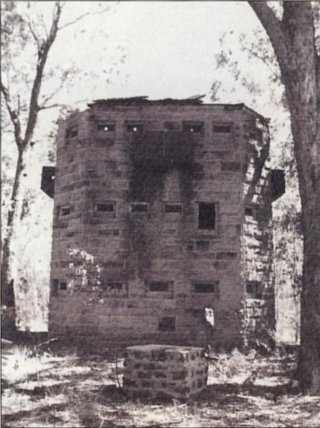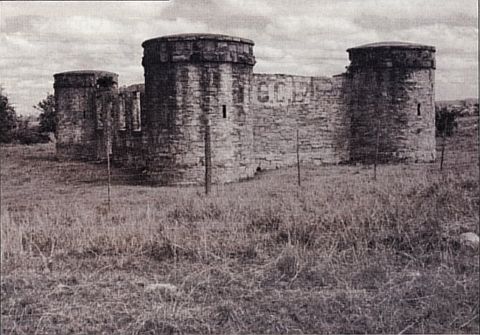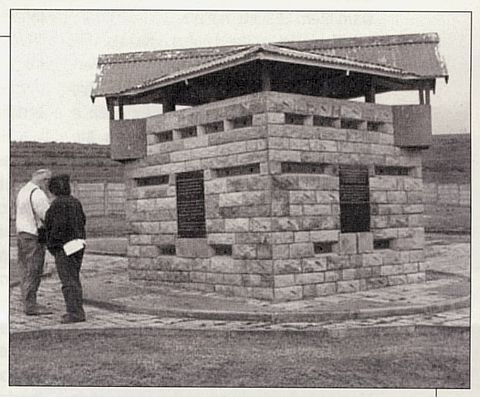

 The South African
The South African
I would like to use the pages of this Journal to pose a question and invite comments from readers on a problem that has arisen since the abolition of the National Monuments Council (NMC) and its replacement by the South African Heritage Resources Agency (SAHRA) in the SAHRA Act of 1999. I write this in my personal capacity as it is a matter close to my heart.
As some of you may know, fortifications in South Africa - and especially those of the Second Anglo-Boer War (ABW, 1899-1902) are a subject which has received my attention for nearly 30 years. I wish to cite a recent case of a particularly fine and rare design of masonry blockhouse in the Free State which is in dire need of attention.
I refer here to the three-storeyed Orange River octagonal example at Riversford (also known as Tierpoort and - Heaven forbid now!- in the contemporary records of the Royal Engineers as 'Kaffir [sic] River'), a few kilometres to the south of Bloemfontein. My association with this building goes back to 1993, when my attention was drawn to its existence when I acquired a copy of a 'voorlegging' (submission) on the building prepared by the NMC; it was provisionally declared a National Monument during 1992-3. I called in July 1993 to measure and record the blockhouse. It features on pp 213-214 of my article on the masonry blockhouses in the December 1997 issue of Military History Journal, and I believe it to be one of only two survivors of this regional design.
In 1997-8 the blockhouse was restored with the help of a grant of R30 000 from the NMC. Amongst other repairs, the internal timber floors at the two upper levels were reinstated and the roof - including the central cupola - was renewed. My next visit was in 2002 when the building appeared in good condition externally.
On 1 October 2008 I called again, hoping to see inside, but the farmer who owns it was away again (so I still have not seen the interior since the restoration). But I was shocked to find the apex cupola of the roof lying on the ground and most of the remainder of the roof in another heap, apparently caused by storm action. In addition, I saw other less urgent defects.
Having just that day called on Johan van Zyl at the AngloBoer War Museum (War Museum of the Boer Republics) in Bloemfontein for a discussion on blockhouses, I wrote to him to report the problems. I suggested that, following his recently expressed enthusiasm for ABW fortifications, here was a problem that he could get his teeth into; but he responded (understandably) that the Museum did not have funds for this sort of work.
Next, I wrote to SAHRA's Free State office and received a reply from Jeanne Nel of the Free State Heritage Council who said they did not get involved in restoration due to an insufficient budget, but she attached a clipping from Volksblad inviting applications for funds for heritage projects to the National Heritage Council.

Blockhouse at Riversford (Photo: R Tomlinson).

The fortified railway gangers' cottage, GC17, near Stutterheim,
stripped of its corrugated iron roof and wooden fittings
within the last ten years (Photo: R Tomlinson).
My next tactic, in mid-December, was to write to the Director at SAHRA Head Office in Cape Town to report the damage, with photos. By late January, I had heard nothing, so I obtained some names at SAHRA Cape Town and sent my letter again 'For attention'. I received a speedy email reply from Dumisani Sibayi, Executive Officer Heritage Resources in Cape Town, saying 'all previous national monuments became provincial heritage resources' with the 1999 Act and are managed by the Provincial Heritage Resources Authority (PHRA), in this case in Bloemfontein; and that SAHRA is only managing national heritage sites (whatever they may be - my comment!). However he would forward my letter to SAHRAFS.
Quickly I received a phone call from Gabriel Tlhapi, Provincial Manager for SAHRA Free State, asking for details of where the problem building is situated and who owns it, which I gladly gave to him. Still no news by early March so I emailed Tlhapi, and he replied that he had 'unfortunately been unable to go to the site because of a very hectic schedule since I am the only official for SAHRA in the Province. Since the building is a Provincial Heritage site I will request the PHRA to look into the matter ... ' A follow-up telephone call this month to PHRAFS has not been successful in advancing the matter further.
So, to summarise, eight months later nothing has happened (apart from a deal of buck-passing) and a building with timber floors exposed to the weather is left to fend for itself. It appears that all 'white' heritage, which includes the entire historic built environment of South Africa declared over a period of 73 years, has been left to the provinces or individual owners to maintain, while the national body, SAHRA, has the onerous duty of caring for everything declared in the last 10 years and major monuments such as the Castle of Good Hope. A concern here with my home province of the Eastern Cape is that PHRA is at present for all practical purposes dysfunctional.
Where does one go from here? The problem with Riversford Blockhouse is that it is located in thick woodland 2km by road from Riversford Farm, is of no practical use to the farmer and probably visited very infrequently by the few people like me who are aware of its existence; so the owner is unlikely to pay good money to fix the problem. The structure should last for a few years after all the timber has rotted and fallen, provided that cement mortar was used in the masonry construction of the walls.
Another blockhouse that I visited during the same tour in September 2008, the unique Standard Pattern variant at Warrenton in the Northern Cape (shown on page 209 of my same article), was not restored and has collapsed because red earth was used as mortar in constructing the stone walls.
Another small National Monument which I recorded recently in the Eastern Cape, the unique Fortified Ganger's Cottage GC17 at Dehne near Stutterheim, was roofed and occupied when I first visited it in 2000, but has since been deserted by its occupants and stripped of its corrugated iron and timber roof and all its window and door joinery, according to local information, by the man into whose keeping it was placed.
South Africa is rapidly losing its historical built environment, much of it of military origin. For me it is a race against time to visit and record these buildings before they are destroyed by vandals or the elements.
Richard Tomlinson,
Port Elizabeth, May 2009
BLOCKHOUSE MONUMENT, DARLING, WESTERN CAPE
My attention was drawn to this interesting structure by Colyn Brookes, who sent me photographs (although I should have picked up on it earlier, as I find it is briefly mentioned in Tony Westby-Nunn's A tourist guide to the Anglo-Boer War, 1899-1902, published in 2000!) I was in the area in June 2007, so decided to visit the structure, which is situated in the new town cemetery along the R315 road from Yzerfontein. The blockhouse is built to the three-storey 'Standard Pattern' to approximately half-scale, the walls being of 'Smart Stone' or similar reconstituted stone, the loophole plates of wood, the machicouli galleries clad in flat asbestoscement and the roof of timber covered in corrugated iron. Instead of the customary door and three shuttered window openings at the middle level, the builder provided four 'doorways', two of which carry polished granite memorial plaques. One is dedicated to three local soldiers, Joshua Metcalf Versfeld, Luit Brian Merrington, and Kapt Henry van Breda Duckitt, killed respectively in 1916, 1943 and 1944, and the other to a 'troopie', Kosie Louw, who died in a skirmish on the Angolan border in 1981. The remaining two doorways are faced with plywood boards, in readiness for the commemoration of any future Darling residents who may be unfortunate enough to be killed in war.
Recently, as a result of my persistent enquiries to Darling Tourism, I received the following information from the municipal files from Mr Johan Truter, the Town Clerk of Darling at the time, on how the monument came to be built:
'[During the Angolan Border War (1966-1989)], 'there were casualties who were usually buried in their home towns, sometimes with a military funeral, and often these young men were not getting due recognition for their services to their country. Kosie Louw, the son of Coenie and Marietjie Louw of the farm, Koekiespan, was the only fatal casualty from the Darling area, and he was buried in the old cemetery.

The unusual scaled-down Blockhouse memorial
in the Darling Cemetery (Photo: R Tomlinson)
During 1984 the Government, in cooperation with the [South African Defence Force], decided that all local municipalities must make ground available for the burial of these war fallen, and this would be known as Hero's Acre. Examples of what these memorials should look like were submitted to the Municipality, but it was up to each to decide for itself. At that stage, Darling was planning a new cemetery and it was decided to place the memorial at the centre. Mr Cassie Schreuder, the then Technical Manager of the Municipality, did the planning and he was responsible for the building of the memorial. It was decided to build a replica of the Blockhouse as seen along the road near Wolseley. We went to physically measure it and took photographs. Seeing it was a replica, it was scaled down to the size of the cemetery. Local builders were used under Mr Schreuder's supervision, and provision was made in case there was need to bury more soldiers. A request was made to the Louw family to rebury their son at the memorial, but they refused. Then the community felt that all soldiers from Darling, who had died in any war for their country, should be honoured at the memorial. Mrs Nicolene Versfeld did the research and the relevant names were engraved on the marble slabs for which it was intended.
The Border War ended, Namibia obtained independence and luckily there were no further casualties from Darling.'
Best regards,
Richard Tomlinson,
Port Elizabeth
Return to Journal Index OR Society's Home page
South African Military History Society / scribe@samilitaryhistory.org